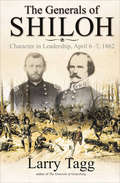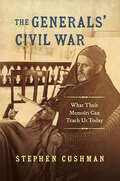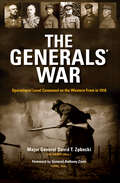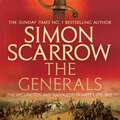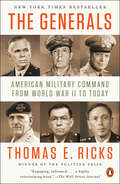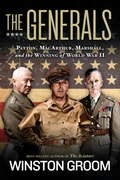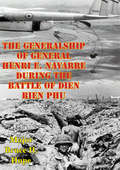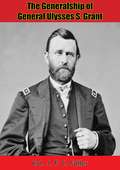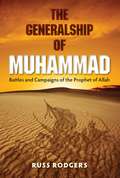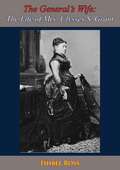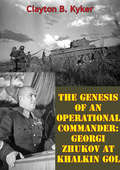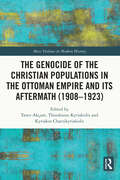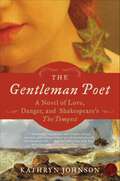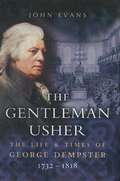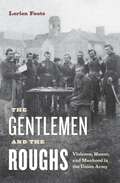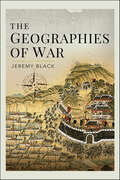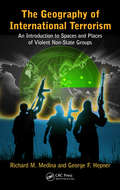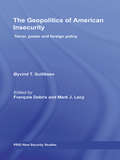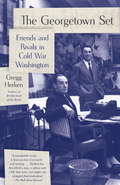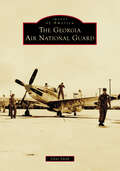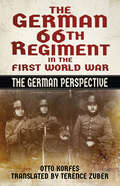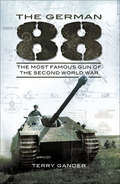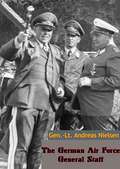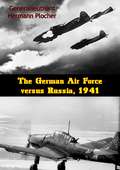- Table View
- List View
The Generals of Shiloh: Character in Leadership, April 6–7, 1862
by Larry TaggThe author of The Generals of Gettysburg examines the characters and actions of the military leadership at this Tennessee Civil War battle. “Character is destiny,” wrote the Greek philosopher Heraclitus more than twenty-five centuries ago. Most writers of military history stress strategy and tactics at the expense of the character of their subjects. Larry Tagg remedies that oversight with The Generals of Shiloh, a unique and invaluable study of the high-ranking combat officers whose conduct in April 1862 helped determine the success or failure of their respective armies, the fate of the war in the Western Theater, and, in turn, the fate of the American union. Tagg presents detailed background information on each of his subjects, coupled with a thorough account of each man’s actions on the field of Shiloh and, if he survived that battle, his fate thereafter. Many of the great names are found here in this early battle, from Ulysses S. Grant, William T. Sherman, and Don Carlos Buell to Albert S. Johnston, Braxton Bragg, and P. G. T. Beauregard. Many more men, whose names crossed the stage of furious combat only to disappear in the smoke on the far side, also populate these pages. Each acted in his own unique fashion. This marriage of character (“the features and attributes of a man”) with his war record offers new insights into how and why a particular soldier acted a certain way, in a certain situation, at a certain time. Nineteenth century combat was an unforgiving cauldron. In that hot fire some grew timid and listless, others demonstrated a tendency toward rashness, and the balance rose to the occasion and did their duty as they understood it. This book explores all of their individual stories. “Does a good job of shining a bright light upon the great preponderance of highly placed citizen-generals in the Shiloh armies.” —Civil War Books and Authors
The Generals' Civil War: What Their Memoirs Can Teach Us Today (Civil War America)
by Stephen CushmanIn December 1885, under the watchful eye of Mark Twain, the publishing firm of Charles L. Webster and Company released the first volume of the Personal Memoirs of Ulysses S. Grant. With a second volume published in March 1886, Grant's memoirs became a popular sensation. Seeking to capitalize on Grant's success and interest in earlier reminiscences by Joseph E. Johnston, William T. Sherman, and Richard Taylor, other Civil War generals such as George B. McClellan and Philip H. Sheridan soon followed suit. Some hewed more closely to Grant's model than others, and their points of similarity and divergence left readers increasingly fascinated with the history and meaning of the nation's great conflict. The writings also dovetailed with a rising desire to see the full sweep of American history chronicled, as its citizens looked to the start of a new century. Professional historians engaged with the memoirs as an important foundation for this work. In this insightful book, Stephen Cushman considers Civil War generals' memoirs as both historical and literary works, revealing how they remain vital to understanding the interaction of memory, imagination, and the writing of American history. Cushman shows how market forces shaped the production of the memoirs and, therefore, memories of the war itself; how audiences have engaged with the works to create ideas of history that fit with time and circumstance; and what these texts tell us about current conflicts over the history and meanings of the Civil War.
The Generals' War: Operational Level Command on the Western Front in 1918 (Twentieth-Century Battles)
by Major General David T. ZabeckiKnown as the War to End all Wars and the Great War, World War I introduced new forms of mass destruction and modern technological warfare. When the Bolsheviks pulled Russia out of the war in late 1917, the Germans turned their offensive efforts to the Western Front in an attempt to win the war in 1918. But as fresh American troops entered Europe, the strategic scales tipped against Germany.Much of how World War I played out turned on the plans and decisions of the senior-most German and Allied commanders. The Generals' War explores the military strategies of those generals during the last year of the Great War. These six very different men included Germany's Field Marshal Paul von Hindenburg and General Erich Ludendorff; France's Marshals Ferdinand Foch and Philippe Pétain; Great Britain's Field Marshal Sir Douglas Haig; and the United States' General John Pershing. Although history remembers none of them as great captains, these six officers determined for better or worse how World War I was fought on the battlefields of the Western Front between November 1917 and November 1918.The Generals' War is a landmark exploration of the generalship that shaped the very framework of modern warfare as we know it today and provides a comprehensive and detailed analysis on the senior commanders of the Great War.
The Generals: (Revolution 2) (Revolution #2)
by Simon ScarrowTHE GENERALS is the compelling second novel in Simon Scarrow's bestselling Wellington and Napoleon quartet. A must read for fans of Robert Harris.In the turbulent aftermath of the French Revolution Napoleon Bonaparte stands accused of treachery and corruption. His reputation is saved by his skill in leading his men to victory in Italy and Egypt. But then he must restore order in France and find peace or victory over her enemies: England - and Arthur Wellesley (the future Duke of Wellington).Wellesley is leading a vast army in India, where British interests are under threat. The campaign will result in the creation of the Raj - the jewel in the British Empire's crown. Wellesley returns to England a hardened veteran and more determined than ever to end France's domination of Europe.Both Wellesley and Napoleon intend to win - whatever the cost. Who will ultimately succeed?
The Generals: American Military Command from World War II to Today
by Thomas E. RicksFrom the #1 bestselling author of Fiasco and The Gamble, an epic history of the decline of American military leadership from World War II to IraqHistory has been kind to the American generals of World War II--Marshall, Eisenhower, Patton, and Bradley--and less kind to the generals of the wars that followed. In The Generals, Thomas E. Ricks sets out to explain why that is. In part it is the story of a widening gulf between performance and accountability. During the Second World War, scores of American generals were relieved of command simply for not being good enough. Today, as one American colonel said bitterly during the Iraq War, "As matters stand now, a private who loses a rifle suffers far greater consequences than a general who loses a war."In The Generals we meet great leaders and suspect ones, generals who rose to the occasion and those who failed themselves and their soldiers. Marshall and Eisenhower cast long shadows over this story, as does the less familiar Marine General O. P. Smith, whose fighting retreat from the Chinese onslaught into Korea in the winter of 1950 snatched a kind of victory from the jaws of annihilation.But Korea also showed the first signs of an army leadership culture that neither punished mediocrity nor particularly rewarded daring. In the Vietnam War, the problem grew worse until, finally, American military leadership bottomed out. The My Lai massacre, Ricks shows us, is the emblematic event of this dark chapter of our history. In the wake of Vietnam a battle for the soul of the U.S. Army was waged with impressive success. It became a transformed institution, reinvigorated from the bottom up. But if the body was highly toned, its head still suffered from familiar problems, resulting in tactically savvy but strategically obtuse leadership that would win battles but end wars badly from the first Iraq War of 1990 through to the present.Ricks has made a close study of America's military leaders for three decades, and in his hands this story resounds with larger meaning: about the transmission of values, about strategic thinking, and about the difference between an organization that learns and one that fails.
The Generals: Patton, MacArthur, Marshall, and the Winning of World War II
by Winston GroomCelebrated historian Winston Groom tells the story of three remarkable men-at-arms who rose from the gruesome hell of the First World War to become the finest generals of their generation during World War II. George Marshall, George Patton, and Douglas MacArthur redefined America's ideas of military leadership and brought forth a new generation of American soldier. Their efforts revealed to the world the grit and determination that would become synonymous with America in the post-war years.
The Generalship Of General Henri E. Navarre During The Battle Of Dien Bien Phu
by Major Bruce H. HupeThis study examines the generalship of the French Commander-in-Chief in Indochina, General Henri E. Navarre, during the battle of Dien Bien Phu in 1954. This thesis employs a model of generalship from the United States Army doctrinal publication, Field Manual 22-103, Leadership and Command at Senior Levels, to analyse the actions of General Navarre. Through the application of the model, this thesis tests whether American doctrine supports or refutes the judgment of history. The conclusion reached is that the defeat of the French forces at the battle of Dien Bien Phu was largely due to a failure of senior level leadership on the part of General Henri E. Navarre.
The Generalship of General Ulysses S. Grant
by Maj.-Gen. J. F. C. Fuller“THE greatest event in European history was the discovery of the New World: today it could only be rivalled by landing on a habitable planet. The greatest event in American history was the Civil War; greater than the Rebellion, because separation from England was sooner or later inevitable. The man who most greatly influenced this war was Ulysses S. Grant; not because he was so clear-sighted a statesman as Lincoln, or so clever a tactician as Lee, but because he was the greatest strategist of his age, of the war, and, consequently, its greatest general.Grant was not of the type of Alexander, Cæsar, Frederick and Napoleon: he was a simple-minded man of vision, and one who for nearly forty years remained an obscure citizen of the Great Republic. It is for this reason that I have dedicated my book on his generalship to the Youth of America; for I believe that the second greatest event in American history was the recent World War, which, cracking the Old World to its foundations, left the United States standing like a granite rock.In writing this book my object has been to examine what Grant accomplished as a soldier; to show that as such he has not been fully appreciated, and that as he looked upon war as a necessary evil so long as peace remains imperfect, we also, after the greatest war in modern times, may find in his honesty and in his vision our direction towards creating a happier and less turbulent world. “Let us have peace,” he said: well then—let us examine war.”—J. F. C. Fuller, Preface
The Generalship of Muhammad: Battles and Campaigns of the Prophet of Allah
by Russ RodgersThere are many biographies of the Prophet, and they tend to fall into three categories: pious works that emphasize the virtues of the early Islamic community, general works for non-Muslim or non-specialist readers, and source-critical works that grapple with historiographical problems inherent in early Islamic history. In The Generalship of Muhammad, Russ Rodgers charts a new path by merging original sources with the latest in military theory to examine Muhammad's military strengths and weaknesses.Incorporating military, political, and economic analyses, Rodgers focuses on Muhammad’s use of insurgency warfare in seventh-century Arabia to gain control of key cities such as Medina. Seeking to understand the operational aspects of these world-changing battles, he provides battlefield maps and explores the supply and logistic problems that would have plagued any military leader at the time.Rodgers explains how Muhammad organized his forces and gradually built his movement against sporadic resistance from his foes. He draws from the hadith literature to shed new light on the nature of the campaigns. He examines the Prophet's intelligence network and the employment of what would today be called special operations forces. And he considers the possibility that Muhammad received outside support to build and maintain his movement as a means to interdict trade routes between the Byzantine Empire and the Sasanid Persians.
The General’s Wife: The Life of Mrs. Ulysses S. Grant
by Ishbel RossAn excellent and diligently researched biography of Julia Boggs Dent Grant (1826-1902), the wife of the 18th President of the United States, Ulysses S. Grant, and First Lady of the United States from 1869 to 1877. An active participant in presidential matters, The First Lady was widely regarded to possess tremendous strength of character, sharing in the mixed fortunes of her husband, promoting his welfare, loved and cared for her family, and fulfilled her patriotic duty as First Lady. She reveled in her role as hostess to the nation, and by all accounts brought warmth and a home-like atmosphere to the White House.Includes over 15 B&W illustrations.
The Genesis Of An Operational Commander: Georgi Zhukov At Khalkin Gol
by Clayton B. KykerThe Red Army's defeat of the Germans during the Second World War is one of the great achievements in military history. The military man most responsible for that victory was Marshal Georgi Zhukov. Though less well known than some of his German or allied counterparts, Zhukov was a brilliant practitioner of a distinctive, and uniquely Soviet, style of operational art. This style was first tested against the Japanese Kwangtung Army at Khalkin Gol in Mongolia. Zhukov's operational scheme at Khalkin Gol was the prototype for his later successes at Moscow, Stalingrad, and Kursk.Zhukov and the Red Army came of age together. Both rose from the ashes of the Tsarist Army and endured two decades of war, debate, reform and crisis. While Zhukov rose through the ranks of the cavalry, the Red Army underwent a period of great intellectual activity. By the mid 1930's, Soviet military theorists began to explore new concepts of successive or "deep" operations that promised to avoid the positional warfare of World War One. During this period, Zhukov became an avowed "tankist" and was extremely well placed to participate in this "renaissance."When Stalin launched his purge of the Red Army in 1937, Zhukov was a Corps Commander. Though interrogated at length, he survived. In 1939, Zhukov, then a Deputy Military District Commander, was summoned to Moscow. Zhukov was relieved to find that he had been ordered to proceed to Khalkin Gol in Mongolia where Soviet troops were facing a Japanese incursion across the border.After assessing the situation, Zhukov prepared a plan to drive the Japanese out of Mongolian territory. Upon assuming command and conducting a massive build-up of combat power, Zhukov launched a devastating offensive spearheaded by massed tanks and artillery that would become the prototype for Soviet offensives during the Second World War.
The Genocide of the Christian Populations in the Ottoman Empire and its Aftermath (Mass Violence in Modern History)
by Taner Akçam Kyriakos Chatzikyriakidis Theodosios KyriakidisDuring the twilight years of the Ottoman Empire, the ethnic tensions between the minority populations within the empire led to the administration carrying out a systematic destruction of the Armenian people. This not only brought 2,000 years of Armenian civilisation within Anatolia to an end but was accompanied by the mass murder of Syriac and Greek Orthodox Christians. Containing a selection of papers presented at The Genocide of the Christian Populations of the Ottoman Empire and Its Aftermath (1908–1923) international conference, hosted by the Chair for Pontic Studies at the Aristotle University of Thessaloniki, this book draws on unpublished archival material and an innovative historiographical approach to analyze events and their legacy in comparative perspective. In order to understand the historical context of the Ottoman Genocide, it is important to study, apart from the Armenian case, the fate of the Greek and Assyrian peoples, providing a more comprehensive understanding of the complexity of the situation. This volume is primarily a research contribution but should also be valued as a supplementary text that would provide secondary reading for undergraduates and postgraduate students.
The Gentleman Poet: A Novel of Love, Danger, and Shakespeare's The Tempest
by Kathryn Johnson“The Gentleman Poet is the best kind of historical novel—well researched, beautifully written, and wildly entertaining.”—Daniel Stashower, author of The Beautiful Cigar GirlThe Gentleman Poet, author Kathryn Johnson’s novel of love, danger, and Shakespeare’s The Tempest, is a wonderful story that imagines a series of astonishing events that just might have inspired the immortal Bard to pen his magical tale. Told from the point of view of a young servant girl who strikes up a friendship with the not yet famous playwright when they are shipwrecked in the Bermudas, The Gentleman Poet gives a delightful new spin on Shakespearean lore reminiscent of the Academy Award-winning film, Shakespeare in Love.
The Gentleman Usher: The Life & Times of George Dempster 1712-1818
by John EvansGeorge Dempster was a giant of a man who became one of the best-known and most deservedly popular Scotsman of his day.He served for thirty years as an MP in Westminster and was closely involved with the expansion of British influence and trade across the world particularly in India and North America. This was the age of Empire building and great rivalry between competing powers, particularly France, which led to protracted warfare.A trained lawyer, Dempster was at the heart of political and business life and his circle of friends was large and powerful. Yet power did not corrupt him and he was respected by allies and opponents, being known as 'Honest George'. Master of the famous Skibo Estate in Sutherland, Dempster's energy was legendary and he used his talents as an entrepreneur and developer, bringing prosperity and jobs to disadvantaged regions.Dempster was more than an observer of history; he made it.
The Gentlemen and the Roughs: Violence, Honor, and Manhood in the Union Army
by Lorien Foote&“A seminal work&” on class divisions within the Union Army—&“One of the best examples of . . . scholarship on the social history of Civil War soldiers&” (The Journal of Southern History). During the Civil War, the Union army appeared cohesive enough to withstand four years of grueling war against the Confederates and to claim victory in 1865. But fractiousness bubbled below the surface of the North&’s presumably united front. Internal fissures were rife within the Union army: class divisions, regional antagonisms, ideological differences, and conflicting personalities all distracted the army from quelling the Southern rebellion. In this highly original contribution to Civil War and gender history, Lorien Foote reveals that these internal battles were fought against the backdrop of manhood. Clashing ideals of manliness produced myriad conflicts, as when educated, refined, and wealthy officers (&“gentlemen&”) found themselves commanding a hard-drinking group of fighters (&“roughs&”)—a dynamic that often resulted in violence and even death. Based on extensive research into previously ignored primary sources, The Gentlemen and the Roughs uncovers holes in our understanding of the men who fought the Civil War and the society that produced them. Finalist for the 2011 Gilder Lehrman Lincoln Prize
The Geographies of War
by Jeremy BlackA global history of the geography of war from antiquity to modern and contemporary conflict illustrated and brought to life by histories of inter-state war, geopolitical rivalry, 'hot' and 'cold' war and terrorism. Geography is a basic element in all stages of war including preparation, planning, onset of conflict, waging wars, assessment of results, post-conflict negotiations, analysis and preparation for future conflict. Geography is the vital element in strategy and tactics, and in the spatial context, on land, water and space. It is central to all historical activities from human and animal transport to wind power, coal, seam, oil, jet propulsion atomic weaponry and the threat of cyber conflict. This is essentially a 'modern geography', and not only physical, but political social, economic, cultural and 'human', with emphasis on personal experience. And technical mapping is included - the author's particular expertise - and accessible to specialist and general readers. A global history of the geographies of war in the context of great power geopolitics to local conflicts.
The Geography of International Terrorism: An Introduction to Spaces and Places of Violent Non-State Groups
by Richard M. Medina George F. HepnerWhile geography is not the only factor to shape human behavior, its influence on terrorists motivations, behaviors, options, and activities is a primary consideration in understanding terrorism. Taking a different approach than many other books on terrorism, The Geography of International Terrorism: An Introduction to Spaces and Places of Violent
The Geopolitics of American Insecurity: Terror, Power and Foreign Policy (PRIO New Security Studies)
by Francois Debrix Mark LacyThis edited volume examines the political, social, and cultural insecurities that the United States is faced with in the aftermath of its post-9/11 foreign policy and military ventures. The contributors critically detail the new strategies and ideologies of control, governance, and hegemony America has devised as a response to these new security threats. The essays explore three primary areas. First, they interrogate the responses to 9/11 that resulted in an attempt at geopolitical mastery by the United States. Second, they examine how the US response to 9/11 led to attempts to secure and control populations inside and outside the United States, resulting in situations that quickly started to escape its control, such as Abu Ghraib and Katrina. Lastly, the chapters investigate links between contemporary regimes of state control and recently recognized threats, arguing that the conduct of everyday life is increasingly conditioned by state-mobilized discourses of security. These discourses are, it is argued, ushering in a geopolitical future characterized by new insecurities and inevitable measures of biopolitical control and governance.
The Georgetown Set
by Gregg HerkenA fascinating, behind-the-scenes history of postwar Washington--a rich and colorful portrait of the close-knit group of journalists, spies, and government officials who waged the Cold War over cocktails and dinner. In the years after World War II, Georgetown's leafy streets were home to an unlikely group of Cold Warriors: a coterie of affluent, well-educated, and connected civilians who helped steer American strategy from the Marshall Plan through McCarthyism, Watergate, and the endgame of Vietnam. The Georgetown set included Phil and Kay Graham, husband-and-wife publishers of The Washington Post; Joe and Stewart Alsop, odd-couple brothers who were among the country's premier political pundits; Frank Wisner, a driven, manic-depressive lawyer in charge of CIA covert operations; and a host of other diplomats, spies, and scholars responsible for crafting America's response to the Soviet Union from Truman to Reagan. This was a smaller, cozier Washington--utterly unlike today's capital--where presidents made foreign policy in consultation with reporters and professors over martinis and hors d'oeuvres, and columnists like the Alsops promoted those policies in the next day's newspapers. Together, they navigated the perilous years of the Cold War, yielding triumphs--and tragedies--with very real consequences for present-day America and the world. Gregg Herken captures their successes and failures and gives us intimate portraits of these dedicated and talented, if deeply flawed, individuals. Throughout, he illuminates the drama of those years, bringing this remarkable roster of men and women and their world not only out into the open but vividly to life.From the Hardcover edition.
The Georgia Air National Guard (Images of America)
by Clint SmithThe Georgia Air National Guard units in Marietta, Savannah, Warner Robins, and other locations have played a role in major conflicts around the world. Clint Smith, a retired member of the Georgia Air National Guard uses images from the Georgia National Guard history office and the Historical Society of the Georgia National Guard to illustrate its history since the guard's official creation in 1947. The founder of the colony of Georgia, Gen. James Oglethorpe, served as the first Georgia Guardsman. He embodied the legend of the minuteman, a tradition carried forward by the Georgia Army National Guard. In May 1941, the first distinct aviation unit was created at Candler Field in Atlanta--the 128th Observation Squadron. In September 1947, a federal act officially created the Air National Guard. Clint Smith served at state headquarters at Dobbins Air Reserve Base in Marietta, Georgia. He had many responsibilities, including command historian. A board member of the Historical Society of the Georgia National Guard, Smith served eight years in the Georgia Legislature, where he led on military and security issues. The author of two novels, Smith has published columns on public policy and history.
The German 1918 Offensives: A Case Study in The Operational Level of War (Strategy and History)
by David T. ZabeckiThis is the first study of the Ludendorff Offensives of 1918 based extensively on key German records presumed to be lost forever after Potsdam was bombed in 1944. In 1997, David T. Zabecki discovered translated copies of these files in a collection of old instructional material at the U.S. Army Command and General Staff College at Fort Leavenworth, Kansas. He presents his findings here for the first time, with a thorough review of the surviving original operational plans and orders, to offer a wealth of fresh insights to the German Offensives of 1918. David T. Zabecki clearly demonstrates how the German failure to exploit the vulnerabilities in the BEF’s rail system led to the failure of the first two offensives, and how inadequacies in the German rail system determined the outcome of the last three offensives. This is a window into the mind of the German General Staff of World War I, with thorough analysis of the German planning and decision making processes during the execution of battles. This is also the first study in English or in German to analyze the specifics of the aborted Operation HAGEN plan. This is also the first study of the 1918 Offensives to focus on the ‘operational level of war’ and on the body of military activity known as ‘the operational art’, rather than on the conventional tactical or strategic levels. This book will be of great interest to all students of World War I, the German Army and of strategic studies and military theory in general.
The German 66th Regiment in the First World War: The German Perspective
by Terence Zuber Otto KorfesGerman Infantry Regiment 66 fought in most of the great battles on the Western Front in the First World War: Le Cateau, First Marne, Arras 1915, the Somme, Chemin des Dames 1917, the German March 1918 offensive, Chemin des Dames 1918, Second Marne and the Siegfried Line. This is the official regimental history, written in 1930 by Major Dr Otto Korfes, an officer in the regiment for most of the war and a Reichsarchiv historian.The German 66th Regiment in the First World War presents a unique insight into the German Army during the Great War, showcasing a perspective all too often ignored. Translated by German Army expert Terence Zuber, it includes maps and pencil sketches by the famed German war artist Döbrich-Steglitz. Containing a viewpoint that will add balance to anyone’s knowledge of the events of 1914–1918, this volume is a must-read for military historians and enthusiasts alike.
The German 88: The Most Famous Gun of the Second World War
by Terry GanderThe German 88 mm guns became the most famous and feared artillery pieces of the Second World War. They appeared in a whole series of forms ranging from anti-aircraft to anti-tank and tank-guns, including several self-propelled platforms. Although primarily anti-aircraft guns they gained an awesome reputation as anti-tank weapons, a reputation that remains to this day. Terry Gander, in this in-depth, highly illustrated study, tells the story of the 88 from its first manifestations during the Great War to its clandestine development in Sweden, its production in Germany, its first 'multi-role' initiation during the Spanish Civil War and its part in the campaigns of 1939-40. As well as a detailed technical description of the gun and its development, his book features vivid accounts of the 88 in action in many of the main theaters of the Second World War, in North Africa, Italy, France and Germany, and on the Eastern Front.
The German Air Force General Staff
by Gen.-Lt. Andreas NielsenThe German Air Force General Staff, first published in 1959, written by Generalleutnant a. D. Andreas Nielsen, is one of a series of historical studies written for the United States Air Force Historical Division by former key officers of the German Air Force for the United States Air Force Historical Division.The overall purpose of the series is threefold: 1) To provide the United States Air Force with a comprehensive and, insofar as possible, authoritative history of a major air force which suffered defeat in World War II; 2) to provide a history of that air force as prepared by many of its principal and responsible leaders; 3) to provide a firsthand account of that air force’s unique combat in a major war with the forces of the Soviet Union. This series of studies therefore covers in large part virtually all phases of the Luftwaffe’s operations and organization, from its camouflaged origin in the Reichswehr, during the period of secret German rearmament following World War I, through its participation in the Spanish Civil War and its massive operations and final defeat in World War II.These studies find their principal authority in their authors’ personal knowledge and experience. Thus, these studies are neither unbiased nor are they “histories” in the ordinary sense of that word. Instead, they constitute a vital part of the story without which the final history of Germany’s role in World War II cannot be written.
The German Air Force versus Russia, 1941
by Generalleutnant Hermann PlocherThe German Air Force versus Russia, 1941, written by Generalleutnant Hermann Plocher, and revised and edited by Mr. Harry Fletcher, is one of a series of historical studies written for the United States Air Force Historical Division by men who had been key officers in the German Air Force during World War II.The overall purpose of the series is twofold: 1) To provide the United States Air Force with a comprehensive and, insofar as possible, authoritative history of a major air force which suffered defeat in World War II, a history prepared by many of the principal and responsible leaders of that air force; 2) to provide a firsthand account of that air force’s unique combat in a major war, especially its fight against the forces of the Soviet Union. This series of studies therefore covers in large part virtually all phases of the Luftwaffe’s operations and organization, from its camouflaged origin in the Reichswehr, during the period of secret German rearmament following World War I, through its participation in the Spanish Civil War and its massive operations and final defeat in World War II, with particular attention to the air war on the Eastern Front.This work, volume one of a series, is devoted to a descriptive account, in some parts in great detail, of German aerial operations in the Eastern Theater of Operations during 1941.
